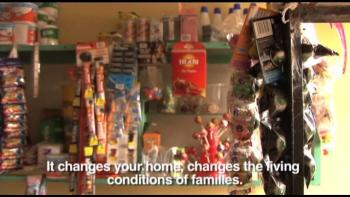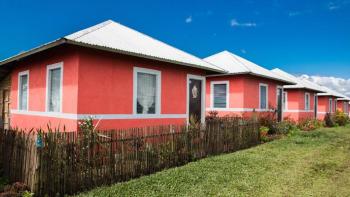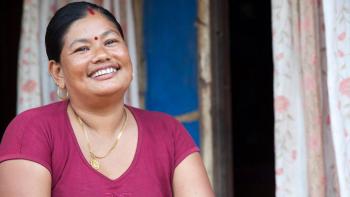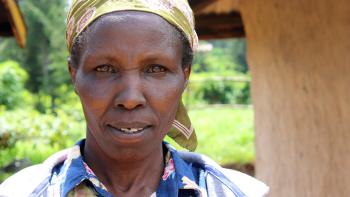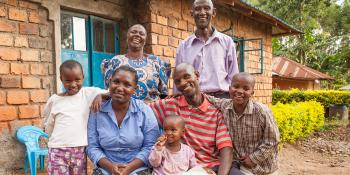
Publications and videos
Advancing the knowledge of housing markets
A core focus of the Terwilliger Center for Innovation in Shelter is advancing the knowledge around housing markets by conducting research studies, creating publications, developing tool kits and scheduling public appearances that foster impact in the sector.
Browse our key publications below, from introductory notes for those interested in learning more about global housing markets to technical guides designed for practitioners.
Housing Microfinance Handbook
This handbook provides detailed instructions, tools and examples for consultants and financial institutions seeking to follow Habitat’s proven five-step methodology for housing microfinance product development.
Case studies and sector reports
Pahal Financial Services - Building Community Resilience through Housing Microfinance (pdf)
Despite India’s fast-growing housing market, access to quality housing has not kept pace, resulting in a significant housing gap – 22% of the country’s population lack adequate shelter. The affordability crisis in India poses a significant challenge, affecting the most vulnerable sections of society. Adequate housing finance has proven to be crucial for bridging the gap between affordable housing demand and accessibility. This case study presents the journey of Pahal, a Non-Banking Financial Services Company, in the development of a housing-focused credit product with technical assistance from the Terwilliger Center for Innovation in Shelter.
Opportunities and Impact of Housing ‘edutainment’ (pdf)
This study employed a mixed-methods research approach to evaluate the “Tujenge: Build It Better” show regarding its impact on expanding knowledge, shifting attitudes and motivating the uptake of affordable housing solutions among households and housing sector actors. It also sought to understand the show’s impact on influencing the media landscape and encouraging the development of similar content. This report outlines the knowledge, attitudes and practices of the target audience toward affordable housing solutions and the extent to which “Tujenge: Build It Better” influenced these outcomes.
A ladder up: The role of the construction sector in creating jobs and rebuilding emerging market economies (pdf) (Spanish)
This 2021 report explores the role of the construction sector in creating jobs and rebuilding emerging market economies in nine countries: Brazil, Colombia, India, Indonesia, Mexico, Peru, the Philippines, South Africa and Uganda.
Housing Microfinance Impact Assessment: Improving Quality of Life (pdf)
Beginning in 2015, Sunrise MCF partnered with Habitat’s Terwilliger Center to improve and expand their housing microfinance products. This new report examines the impact of two products – energy efficiency and home improvement loans – on low-income borrowers’ quality of life.
Cornerstone of Recovery: How Housing Can Help Emerging Market Economies Rebound from COVID-19 (English | Spanish | French)
This report documents housing’s true contribution to gross domestic product by analyzing 11 emerging market countries, where evidence on the total size of housing investments is often lacking. It explores the potential underestimation of the housing sector by official statistics and examines whether the housing sector could support economic recovery while creating safer, healthier housing for low-income households. The report offers inclusive housing proposals for the public and private sector to respond to COVID-19.
Exploring the adoption of housing microfinance within the Georgian market (pdf)
Institutions that received capital and technical assistance from the MicroBuild Fund often subsequently scale their housing portfolios. This publication explores the question: Has the success of MicroBuild Fund investee institutions yielded a crowding-in effect, whereby non-MicroBuild Fund financial institutions adopted and scaled housing microfinance products?
The Business Case for Housing Microfinance Sub-Saharan Africa (pdf)
This publication looks at the demand for housing microfinance, its value proposition and the competitive advantage of differentiated housing microfinance products. It identifies factors key to the success and profitability of housing microfinance products, based on analysis of the work of Uganda’s Centenary Bank and Kenya Women Microfinance Bank.
Beyond Building: How Social Norms Shape Low-Income Home Construction (Executive summary | Kenya | India| Peru)
This three country research gathers insights on how social norms influence housing decision-making and encourages change-makers to look beyond the obvious obstacles that low-income homeowners face — poor land tenure, lack of financing, access to materials and design advice — to less obvious obstacles, such as unhealthy social norms and poor information flows that greatly impede housing outcomes.
- Women’s work and men’s decisions: Gender norms in low-income homebuilding (pdf)
- Preparing for the worst: How low-income household and mason attitudes on home construction affect disaster resilience (pdf)
- Hand in hand with homeowners: How mason’s norms and practices affect low-income home construction in India, Kenya and Peru (pdf)
The 2016-17 State of Housing Microfinance: Understanding the Business Case for Housing Microfinance (pdf) (English | Spanish)
This report, based upon a survey of over 101 housing microfinance practitioners, is composed of insights and findings regarding practitioners’ perceptions of the challenges and opportunities facing housing microfinance, successful implementation strategies and the performance of housing microfinance portfolios. Using a simple framework to analyze these responses at a regional and global level, we explore the market-level, institutional-level, product segmentation level and profitability drivers that make differentiated housing microfinance products a viable and attractive option for financial service providers.
State of Investment in Affordable Housing (pdf) (English | Spanish)
This publication is based upon on the results of a survey conducted among leading impact investors from Europe and the USA in emerging and frontier markets, with a particular focus on: Investors’ current activity in housing, plans for investments into the sector, and opportunities and perceived risks from an investor’s perspective.
The 2015-16 State of Housing Microfinance: A Review of the Housing Microfinance Practice Around the Globe (English | Spanish)
Based upon responses from 83 financial institutions practicing housing microfinance, this second edition of the housing microfinance survey assesses the current state, trends and challenges of the global housing microfinance sector. This edition explores the nuances of housing microfinance portfolios as distinct from those of overall lending portfolios and includes a special focus on tenure security.
2014-15 State of Housing Microfinance report (pdf)
This report assesses the current state, trends and challenges of housing microfinance based on a 2014 survey of 48 financial institutions located across four regions: Latin America and the Caribbean, Asia and the Pacific, Africa and the Middle East, and Eastern Europe and Central Asia.
Housing microfinance case studies of 11 Habitat partnerships (pdf)
These cases, chosen from a variety of contexts, portray microfinance institutions at distinct stages of housing microfinance product implementation and scale-up, and feature 11 countries from four regions: Latin America, Africa, Asia and Europe.
Lessons from 11 partnerships of Habitat for Humanity (pdf)
Case studies on housing microfinance topics such as opportunities and constraints, housing support services, product development and taking products to scale, from 11 of Habitat’s microfinance institution partners and their experiences with housing microfinance.
Shelter innovation highlights
Market systems concept note: August 2018 (pdf)
Habitat for Humanity has worked through markets to improve access to finance for more than three million low-income households in the past decade, but numerous challenges related to construction materials, services, housing knowledge and policies remain. In this strategy document, Habitat’s Terwilliger Center for Innovation in Shelter lays out its market systems development approach to address these challenges.
Microsavings for housing finance: June 2017 (pdf)
Habitat recently explored microsavings products for housing through a pilot program implemented by our Terwilliger Center for Innovation in Shelter, in partnership with the Citi Foundation. Five takeaways from the project, combined with previous research on microsavings, help to build a fuller understanding of what may and may not work in housing microsavings.
Alternatives to the RCT: Measuring impact in affordable housing programs: June 2017 (pdf)
This brief introduces the methodology used by Habitat for Humanity’s Terwilliger Center for Innovation in Shelter in partnership with Oxfam Novib to assess two housing finance initiatives: one in Bosnia and Herzegovina and the other in El Salvador.
Global
How can microfinance for housing, land and infrastructure catalyze slum improvements and new settlements? (pdf)
This paper, co-written by the Terwilliger Center’s Patrick Kelley, discusses slums in large cities in the developing world and the critical role that housing microfinance plays in improving housing conditions for many of the slum’s marginalized households.
Capitalizing housing for the poor: Findings from five focus countries (pdf)
This report seeks to inform the impact investment community, as well as the microfinance sector at large, about the opportunities and barriers for investment in the growth of housing microfinance in India, the Philippines, Peru, Uganda and Mexico.
Latin America and the Caribbean
Knowledge Product: Barriers to Housing Program Subsidies in Peru (pdf) (Spanish)
What are the barriers preventing low-income families from accessing existing housing subsidies in Peru? How can we revitalize these benefits for those at the bottom of the pyramid? The Terwilliger Center undertook an in-depth analysis of housing subsidy programs, which is summarized in this knowledge product. Based on this research and our experience in the national construction market, we also propose a number of alternative solutions.
eBook: Rockstars de Innovación en Vivienda (pdf) (Spanish)
Jointly produced by Habitat’s Terwilliger Center and ESMEX, Rockstars de Innovación en Vivienda [Rockstars of Housing Innovation] is an eBook showcasing the housing need in Latin America, with inspiring case studies of solutions to motivate others to join in the effort to reduce the deficit through innovation. In addition to inspiring and raising awareness on issues of social innovation and access to housing, these six rockstars recount step-by-step their creative process to solving a specific housing problem. The book is divided into three sections: design services, construction materials and services.
Asia and the Pacific
Green and disaster-resilient affordable housing video guides
Low-income families are bearing the greatest brunt of the impact of climate change. Across the globe, billions of people don’t have a safe place to call home. Many are forced to rebuild their houses several times a year due to natural disasters. Watch our video guides to learn more about how to build or renovate your home with efficiency and savings.
Green housing solutions in the Philippines: Making sustainable, circular housing more accessible and affordable for low-income households (pdf)
Habitat for Humanity International’s Terwilliger Center for Innovation in Shelter collaborated with Engineering for Change and other industry leaders to research the landscape of sustainable, green and circular housing solutions in the Philippines. This effort aimed to answer the question “How might we make green housing more affordable and accessible for financial service providers, builders and end-users” in the Philippines. This paper draws heavily on that work while offering updated insights on what is next for green affordable housing in the country.
Habitat for Humanity and KOMIDA: Helping families achieve security and pride through improved housing conditions (pdf)
In Indonesia, the world’s fourth most populous country, 22 million households live in homes with at least one substandard feature such as overcrowding or lack of access to basic services, according to the World Bank. KOMIDA, one of the largest microfinance institutions in Indonesia, partnered with Habitat for Humanity’s Terwilliger Center for Innovation in Shelter to develop a people-centered housing microfinance solution aligned with KOMIDA’s social mission.
Wood and Cement Industries for Low-Income Incremental Home Builders in the Visayas Region: A Rapid Market Study (pdf)
In the Philippines, most low-income housing has poor foundation, walling and roofing systems, despite the importance of these materials for the construction or renovation of resilient and safe homes. The rapid market study aims to understand the current state of the wood and cement markets in the Visayas Region, identify critical factors affecting supply and demand, and recommend appropriate and innovative market-based solutions to support the availability and accessibility of quality and affordable building materials for low-income households doing incremental building.
The Missing Middle: A market study on small and medium enterprise financing in the housing market system in the Visayas (pdf)
In the Philippines, small and medium enterprises, or SMEs, play a crucial role in providing low-income families the products and services they need to build or repair their homes. However, SMEs are still challenged with a lack of access to finance and weak business support systems. This study provides an understanding of small and medium enterprises that comprise the “missing middle” in the housing market value chain in the Visayas region. It also presents appropriate recommendations and identify innovative interventions to support the availability and accessibility of quality and affordable building materials for low-income households.
Case study: Achieving affordable housing through microfinance loans in Nepal (pdf)
In Nepal, microfinance institutions are an important channel through which low-income families can access financial services. Despite the opportunities, home improvement financing remains an untapped market segment. This case study features the journey of Jeevan Bikas Laghubitta Bittiya Sanstha Limited and their partnership with the Terwilliger Center for Innovation in Shelter and Habitat for Humanity Nepal, for the development of a viable and client-centric housing product, to promote adequate shelter among low-income households in the country.
Financing better roofs: case studies from the Terwilliger Center’s work with LaRaksha in India
(Pakkiriammal’s story | Amuthavalli’s story)
The Terwilliger Center is helping families in Tamil Nandu improve their roofs through a partnership with the non-profit microfinance institution microfinance institution LaRaksha. These two case studies illustrate how a new roofing loan product is enabling families replaced their thatched rooves, with more durable and climate-resilient tile roofs, thereby improving their living conditions and saving them money from frequent disaster-related repairs.
Case study: Improving access to housing microfinance solutions among low-income households in the Philippine (pdf)
This case study showcases the journey from product design and training to the pilot program’s end, highlighting the challenges, achievements and opportunities. The study is useful for all market actors such as financial intermediaries, investors, regulators, business consortiums and others interested in promoting adequate housing among low-income households.
Impact of COVID-19 on the low-income housing market systems in the Philippines (pdf)
This study analyzes the economic and social impact of the COVID-19 pandemic on the housing market systems of low-income households in the Philippines, and the effectiveness of institutional support that has been planned and provided thus far to low-income housing market actors.
Clearing the housing backlog: An updated supply and demand study on the owner-driven construction segment in the Philippines (pdf)
This study estimates the market size of the owner-driven construction housing segment in the Philippines, to understand the opportunities and positive impact of tapping this unserved population. Such information could support future investment and policy decisions among public, private and non-government organizations.
Leaving the city behind - Rapid assessment with migrant workers (pdf)
This rapid market assessment examined the lives of Indian migrant workers at their place of work prior to a nationwide lockdown that was enacted following the COVID-19 pandemic, the changes that they encountered during the lockdown and their outlook beyond the lockdown.
Housing microfinance in practice: Lanka Orix Leasing Company in Cambodia (pdf)
This case study, which looks at one of the leading microfinance institutions in Cambodia, provides insights on housing microfinance product development with particular focus on the support processes necessary to sustain this product, such as creating specialized positions and conducting staff trainings throughout the process.
Bahay, Buhay: A survey of disaster-prone areas in Cebu Province, Philippines (pdf)
This is a survey of owner-driven housing construction, practices, financing modalities and aspirations for a resilient home in disaster-prone areas in Cebu Province, Philippines.
The Impact of Housing Microfinance: An Independent Institutional and Social Impact Evaluation of Two Housing Microfinance Products in South India (pdf)
This assessment is intended to help us understand the positive and negative impact that access to housing microfinance loans has on low-income households and to chart a future course of action.
Lessons from Citi-Habitat Home Improvement Microsavings Program (pdf)
This report explores the lessons from the Citi-Habitat Home Improvement Microsavings Pilot Program in the Philippines and Thailand.
Inclusive finance for housing: Exploring viable business models (pdf)
This study is based on analysis of grants issued by USAID to three global networks, including Habitat for Humanity in India and discusses the challenges and opportunities in introducing housing microfinance and complementary services at scale.
Asia’s poor should be helped to save for a better home
According to Patrick McAllister, Terwilliger Center consultant and author of this op-ed for the South China Morning Post, smart regulations, new technology and incentives are some of the ways to help low-income families save for a better home.
Europe, the Middle East and Africa
Housing Microfinance and Tenure Security: Understanding Their Relationship in Uganda (pdf)
This report was commissioned as part of the Building Assets, Unlocking Access, or BAUA, project and presents key findings on the interrelation of housing microfinance and land tenure security in Uganda. Conducted in partnership with the Mastercard Foundation, it focuses on increasing access for households in the base of the pyramid to the financial services necessary to improve their living conditions.
Housing microfinance in practice: A case study on Al Majmoua in Lebanon (pdf)
The Lebanese Association for Development, or Al Majmoua, is committed to serving low-income microentrepreneurs, particularly women, by providing them with group and individual loans to improve their economic and social conditions. In 2008, Al Majmoua entered into a partnership with Habitat for Humanity Lebanon to design and deliver a housing microfinance product with construction technical assistance.
Housing microfinance in practice: A case study on Microcredit Foundation Sunrise in Bosnia and Herzegovina (pdf)
This case study reviews the process Sunrise went through to develop and refine its housing product. In particular, it provides insights into how a client-centric strategy can strengthen alignment of the product with clients’ needs.
Kenya Women Microfinance Bank Housing microfinance impact evaluation final report (pdf)
Genesis Analytics, along with the Leibniz Institute for Economic Research, were contracted by Habitat’s Terwilliger Center in 2013 to conduct an impact evaluation of the Building Assets, Unlocking Access project in Kenya.
Building Assets, Unlocking Access: Centenary Bank impact evaluation report (pdf)
Genesis Analytics, along with the Leibniz Institute for Economic Research, were contracted by Habitat’s Terwilliger Center to conduct an impact evaluation of the Building Assets, Unlocking Access project in Uganda.
Kenya market mapping report (pdf)
This study deepens and strengthens the understanding of Kenya’s low-income housing sector for financial service providers and other stakeholders in order to increase their ability to provide affordable products that promote access to housing for the low-income communities.
Uganda market mapping report (pdf)
This study improves the understanding of Uganda’s low-income housing sector for financial service providers and other stakeholders in order to increase their ability to provide affordable products that promote access to housing for the low-income earning communities.
